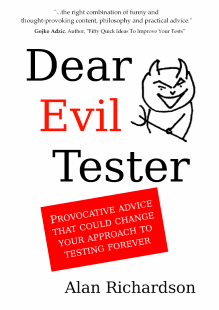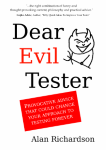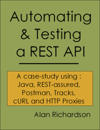During the creation of Dear Evil Tester I posted a running commentary with information about the self publishing process. This post collates the smaller posts together in an edited format and acts as a primer of the self publishing process.
Announcement
This book contains the kind of humour that I relate to most.
Huib Schoots said “Alan writes with a dark humour that I like a lot!”
Richard Bradshaw called it “a warm dark blanket of humour and wit”.
I wrote “Dear Evil Tester” because I saw a gap in the coverage of current testing books. I don’t see many testing books which cover the ‘Attitude’ that we need and want testers to build up.
This is a Question and Answer book.
And the answers are written in a way that I needed/wanted someone to talk to me when I was growing up as a tester. Someone who’s answers would force me to think about whether I thought what we were going was a good idea and caused me to take responsibility for my test approach. Not because it was what the process said, or because it was what the ’experts’ say, instead because it was what we say.
I learned to do this.
Hopefully with enough experience we learn to do this. So testers who have more experience will be able to relate to the book on this level. And testers with less experience will hopefully have that experience as they read the book.
We can use humour to challenge how we think, just as we use humour as a defense mechanism. In some ways I’ve drawn upon my readings of Provocative Therapy with a “Devil’s Advocate” approach to provide answers which lead to a change of attitude.
Rob Sabourin said “I laughed - then I cried - then I laughed harder - then I cried softer.”
Book editing with testing hints on Observation
A proof copy of “Dear Evil Tester” offers the opportunity to take a different perspective.
So now, with a different observation tool (the book instead of the printout). I will start to spot different errors.
Observation is one of the key parts of my simple testing model:
- Modelling, Observation, Reflection, Intent, Manipulation
This model changes for technical testing to:
- Modelling, Observation, Reflection (contains intent), Interrogation, Manipulation
Different tools change the way that we observe. Different printouts are no different.
Proof Editing
A quick behind the scenes look at the pre-proof editing process used when I’m writing a book via leanpub.com.
In this video you will see all the tips and tricks of the trade.
The super secret special pen that I use for editing (clue: its a “Fisher Military Space Pen Matt Black”).
The hi-tech editing software in use (clue: its a text editor, in this case Sublime Text).
The hi-tech version control software in use (clue: its subversion because I’m like that at home).
The sophisticated deploy system (clue: a windows batch file).
The hi-tech local to remote environment synchronisation software (clue: Dropbox)
And the highly automated preview process (clue: I click on a link in leanpub.com)
How to Draw Evil Tester
“Dear Evil Tester” includes some Evil Tester images and comics.
In this post I will show the basic process I use to go from a scribbled, draft, pencil drawing, to an inked and digital comic.
You’ll see (in super blurry vision because of the web cam autofocus) the draft A3 sheets.
Then we move to an A4 pencil sketch. And then to an A4 ink sketch.
And we’ll finish with a quick demo of the tools we need to scan it in and polish it up on the computer.
To scan the drawings I use a Canon Lide 220. Small, easy to store, USB powered (minimises cable and setup hassle), portable to different machines in different rooms. Fast enough. (For document scanning with multiple pages I use a ScanSnap ix500)
I scanned into Paint .Net and I used Riot to shrink the file sizes.
Launch Day
I suspect ‘professionals’ create a plan and stick to it. I’m more of a kanban, ship it when it is ready, kind of guy.
On the 16th March 2016, I received a final proof copy, and I reviewed that. Then on the 17th I hit publish.
I found the free pdf comparison tool “diff-pdf” very useful for final leanpub print ready pdf comparison during my final proof phase.
The launch process proceeded as follows:
- start at leanpub
- check the book details
- realise you haven’t added a price
- add price (make it slightly cheaper than amazon kindle because of the difference in royalty rates)
- click publish
- check the page looks OK in incognito mode
- tweet
- tweet that a sample is available now so people can try before they buy
- move on to createspace
- click publish
- stare at the message that says “this might take 3-4 days” and wonder how people manage to create a co-ordinated launch across all platforms
- move on to kdp (kindle direct publishing)
- click publish
- again stare aghast at the “this might take 3-4 days” message
- be amazed as you start responding to peeps tweets about buying the book. Thank you all.
- see that Amazon.co.uk have listed the book for sale
- tweet that
- start editing all your web pages
- notice that the feedjs server you were relying on for your rss feeds has stopped responding, so create a new endpoint for your existing rss caching to work on different sites
- notice that the kindle version has been published
- tweet that
- respond to more peeps tweets. Thank you all again.
- Write a promotional blog post
I still have more to do in the launch.
- make sure Amazon notice that the paperback and kindle book are actually the same book and are listed together
- create a leanpub promo video
- amend the sales pages
But overall, the ‘publish’ part of ‘self publishing’ has become quite smooth.
A Style Guide
During the editing stages of “Dear Evil Tester” I started to write and maintain a style guide.
This was to help me track the ‘basic’ errors I found in my writing, and as an attempt to ensure a consistent attitude and formatting in the text.
Most books, and “Dear Evil Tester” is no exception, have a ‘conventions used in this book section’. This is a mini style guide which contains a set of small templates that I can use during the writing process. This section doesn’t go so far as to list the weaknesses of the writer, which is one reason for making it public. Whereas the weaknesses can be inferred from the reading of a style guide, so we keep it secret.
I’ve embedded the style guide below.
But first… a quick reflection since I will carry this approach forward into my testing.
I generally make a lot of notes when I’m testing. I do not always summarise them into a concise guide. I will now.
I’ll write down the:
- handy tips,
- obvious errors I commit,
- reminders of high level aims.
Previously I’ve relied on my archive of notes and ‘searching’ through them, which has worked well. But I think that the additional exercise of reviewing, and summarising, will help embed the knowledge in my head which might even cut down on the searching.
It should also make it possible to share with other people.
I know that we have tried to do this on projects through wiki’s but, they often fall into disuse. Partly because they are written to be ‘read’, rather than ‘remind’, so are often wordier than they need to be. Also they tend to be written for ‘others’ rather than for ‘ourselves’.
Having the guide for my testing, might also help ‘others’ spot weaknesses in my approach. For example, if I haven’t listed a shortcut/feature in the tools then I might be missing out on something that might help my testing. The guide might reveal that to someone more expert than myself.
I’ve had in mind to build these for each of my websites. When I do, this will also have the side-effect of creating a single page that I can quickly review for any obvious CSS or common JavaScript issues.
And now, the style guide…
Evil Tester Writing Style Guide
This is the ‘writing style guide’ to support editors for Dear Evil Tester.
But Alan, that’s you! Yeah, and I forget stuff. OK!
Sublime Tips:
ctrl + shift + F- Find across all filesF6- Spellcheck
Publishing Tips
- Remember to check in to Version Control before starting a preview
- Remember to deploy to Dropbox before starting a preview
- Remember to close down PDF viewer, before starting a preview
Editing reminders
If you find an error. “Find across all files” and see if you find it again - if you do, fix it!
When reading from print, to find the file, use “Find across all files”
Writing Style
Worry less about the sentence structure. Worry more about the flow. Think. What would Norvell Page write? What would Lester Dent write? Do not model H. P. Lovecraft.
Is it a sentence? Who cares. Just make sure it looks like one. And reads like one.
But we’re not supposed to start with a conjunction!
And who said that? Was it someone who started a sentence with “however”? What would the author of the Bible write? (Hint: And in paragraph two, they started with “And”! If its good enough for God…)
But…
- If you have (brackets) and have punctuation outside the brackets (like this), then it is only outside if it started outside. (Having a full stop outside this would be bad.)
- Its vs it’s (remember: find across all files) - It’s wrong to write its, unless its thing is being described.
- Don’t worry too much about capitalisation, but at least make it consistent in each letter.
- PS. PPS. (Don’t make it a dotty abbreviation.)
- Capitals for Things,
- at the very least don’t mix it. “exploratory Testing” would be bad.
- Chapter and Section Titles use Capitals
- Letter chapters are written like sentences. Unless they have a Thing in it.
- For example, we will not write For Example. And we will still write e.g.
But what about the readers that know grammar?
Ha. They’re going to be annoyed however you write it. Write it for the masses.
Recurring Jokes
If you ever get the opportunity to make a joke about repetition then you should take it. Copy and paste a previous section of text again. Preferably the previous sentence or paragraph. Some people will get it. Some people won’t notice. Some will call the grammar police. Either way, much hilarity shall ensue. So if you ever get the opportunity to make a joke about repetition then you should take it.
Release Debrief
Errors found in the staging environment
Upon reading the proof copy, I found two tiny errors. Did I delay publishing? Heck no. I’m Agile. I’m lean (with a thin layer of fat for winter).
Did I fix the errors?
Errors found late can cost more to fix than early
Heck yes.
What were they?
Two typos.
- I had written a " instead of a :
- I missed out one character from the end of a word
I could probably have left the second error. But the first one annoyed me. Especially since I was sure I had fixed it prior to ordering the proof.
I could have hit publish, there and then, but I didn’t I fixed the error.
Integration Testing
But I don’t have any integration tests. How could I check I had fixed it?
I needed to improve my test approach. Previously I had been scanning the changed pages, and flipping through the pages to check for no unexpected changes. Then order a proof. Then wait 3 days. Then repeat.
This time I found a tool to help. diff-pdf
Perhaps, I could generate a ‘print ready pdf’ and ‘diff’ it with the previous one.
It worked. The diff showed me two pages with changes, and both exactly where I expected them.
I was pretty sure this was good enough to de-risk the release process.
Release Process
But I still had to go through a release process.
I had to resubmit the print ready proof to the CreateSpace process.
Then wait for the ‘we check your document’ process to complete.
But that would take too long. I had already started the “Coming Soon” hype machine. I couldn’t dial it back into “Coming a little bit less soon than I wanted, but still Coming Soon” mode. Or I could, but I didn’t want to.
So on Thursday morning. After the CreateSpace approval process was finished I was able to review the digital proof of the book.
I wasn’t so sure this was good enough to de-risk the release process. Because I didn’t gain any information. I didn’t notice any problems. I didn’t think there were any problems. So this just confirmed my world view.
In theory, this should mean that I found no additional risks and issues, and so should be good to go.
As a tester, I’m not used to finding no problems. I must have missed something.
I could order a print copy, wait a few days, then compare the text, and then release. If I did that I probably wouldn’t release the book for another 5 days.
What to do? What to do?
What to do?
On Thursday.
I ordered a print proof.
And I went live.
I thought - if there was a problem then I would receive the proof copy before anyone received there copy.
Friday, Saturday, Sunday
On Friday, people started tweeting that they had received their print copies from Amazon.
HUH! WHAT! My proof still hadn’t arrived!
On Saturday, people tweeted that they had received their print copies from Amazon.
WAIT! But my proof copy still hadn’t arrived!
On Sunday… etc.
Monday
And lo! The proof copy arrived.
I read through it and it looks fine.
Lessons learned
- Release Go Live decisions are always a risk based decision.
- Sometimes business priorities will take precedence over ’testing’ risks and concerns.
- Tools can help.
- You have to know what you need a tool to do, before you find one.
- If you self-publish, then try to order your final proof from Amazon rather than CreateSpace. It will arrive faster.
Google Alerts for Brand Monitoring
After publishing “Dear Evil Tester” I setup a Google Alert.
This alerted me to book reviews.
As far as I know, there are two book reviews out there in the wild:
I never know quite what I’ll find when I click on a book review, and having written a few reviews myself, I know how cutting they can be if the reader didn’t get on with the book.
Fortunately both Jason and Mel seemed to enjoy the book.
Jason has a lot of book notes and summaries on his web site. I’ve subscribed to his RSS feed now, so I’ll see what other books and quotes have resonated with him.
Mel wrote the book in a “Dear Evil Tester” letter style which included kind words about the book:
This book had me laughing at my desk and my coworkers wondering if I had gone around the bin. I was enchanted by the sarcasm and wit, but drawn to the practical advice you had in your answers given with the Evil Tester persona.
Mel also recommended a few other books to readers of her blog. I’ll let you jump over to her site and read the review to find out the other books she mentions.
Hopefully I’ll find new book reviews popping up occasionally, of course the sales and marketing department here at EvilTesting Towers might selectively choose which reviews we mention.
Thanks Mel, and Jason - and also thanks to those that reviewed on Amazon - Isabel, Lisa and B. Long








